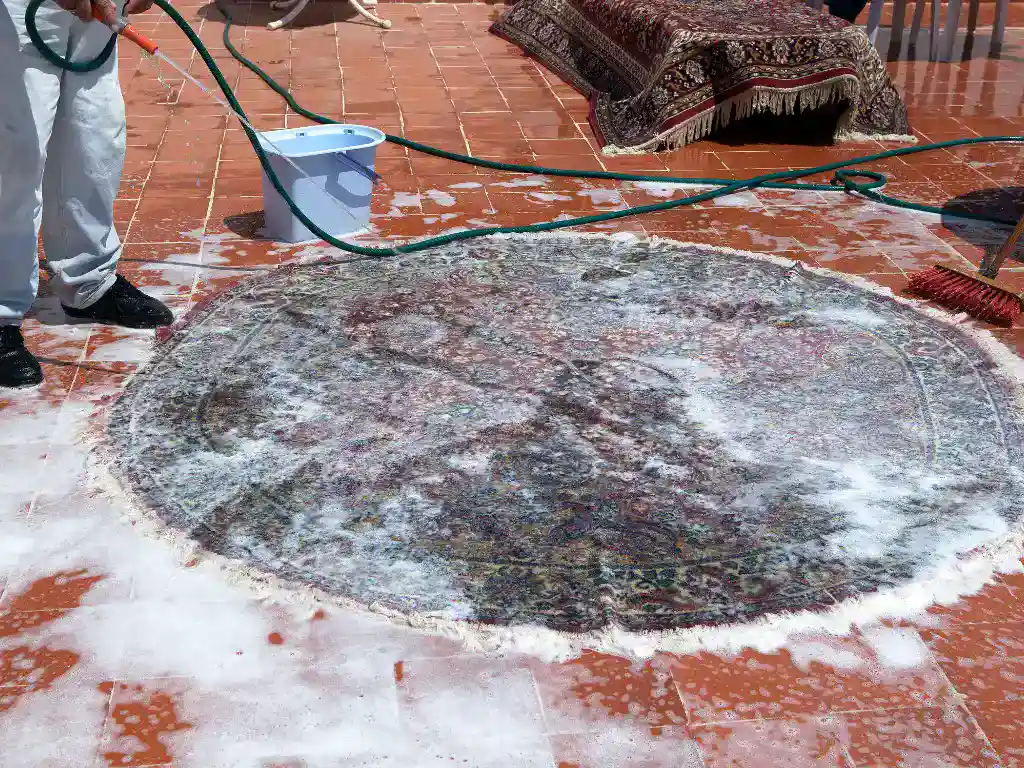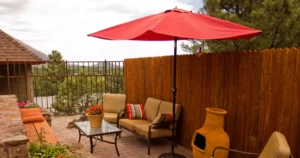Do you ever look at your outdoor rugs and wonder how you can get them to look fresh and clean again? I know I’ve been there – after a while, all that dirt, debris, and spills really start to take their toll no matter how much you vacuum. That’s where pressure washing comes in.
As you’ve probably noticed if you’ve tried cleaning your outdoor rugs by hand, it takes forever and you still can’t seem to get them truly clean. This is where I’ll show you my tried and tested method for how to clean an outdoor rug with a pressure washer. Pressure washing is honestly the best way I’ve found to deep clean rugs outside.
It blasts away all that ground-in dirt much better than any vacuum or scrub brush ever could. After a while, your rugs really need that heavy-duty cleaning in order to maintain their appearance and make them last. In this guide, I’m going to give you all the tips and tricks I’ve learned over the years on how to use a pressure washer to restore your outdoor rugs.
I’ll cover everything from choosing the right pressure washer settings to use on different materials, safety techniques for protecting your rugs and yourself, and how to properly dry your rugs afterward. By the end, you’ll know exactly how to clean outdoor rugs with a pressure washer like a pro. So, let’s get started and I’ll show you my simple process!
Benefits of using a pressure washer to clean outdoor rugs
There are many benefits to using a pressure washer rather than hand scrubbing to clean outdoor rugs. Pressure washing utilizes high-powered water spray rather than manual labor to remove dirt, debris, and stains deep in rug fibers. Here are some notable benefits of this method:
- Thorough cleaning – Pressure washers blast away stubborn dirt, grime, and residue that vacuuming alone can’t remove. Their intense spray reaches into rug fibers to get rugs truly clean.
- Large surface areas – Pressure washing makes quick work of cleaning even extra-large outdoor rugs. There’s no need to spend hours on hands and knees scrubbing.
- Revives materials – The powerful spray restores colors and vibrancy by removing built-up substances like pollen, mold, mildew, and algae. This extends the life of rug materials.
- Environmentally friendly – Water is the main cleaning agent with pressure washers. Minimal or no chemicals are required compared to other cleaning methods.
- Adjustable settings – The pressure, spray pattern and nozzle can be tailored to safely and effectively clean different rug textures and materials.
- Versatile tool – A pressure washer cleans more than just rugs, like decking, furniture, and siding.
With the deep cleaning capability of a pressure washer, it’s an ideal tool for bringing old, dirty outdoor rugs back to new condition. Keep reading to learn how to choose the right washer and safely use it to clean your outdoor rugs.
Choosing the Right Pressure Washer for Outdoor Rugs
Not all pressure washers are created equal. To cleanly pressure wash outdoor rugs, it’s important to select a pressure washer with adequate power and key features. Factors to keep in mind when shopping:
- Pressure Rating – Look for a pressure washer that outputs at least 2,500-3,000PSI (pounds per square inch) of water pressure. Higher PSI blasts away more stubborn dirt without damaging sensitive rug fibers.
- Water Volume – A water volume of at least 2.0 gallons per minute (GPM) provides enough water flow combined with pressure for efficient cleaning. More water flow increases cleaning effectiveness.
- Power Source – Gas pressure washers tend to offer the highest power levels needed to thoroughly clean heavily soiled or large rugs. Electric models are lighter on power but sufficient for routine maintenance.
- Hose Length – A hose measuring at least 20 feet allows cleaning of hard-to-reach areas of extra-large rugs without repositioning the washer as often.
- Accessories – Additional angled spray nozzles, surface cleaners, extension wands, and roof washers help optimize cleaning different rug textures and materials.
- Durability – Look for an all-metal pump with a protective casing to prevent damage from outdoor use and potential water backflow.
Armed with the proper pressure washer, you’ll easily conquer even the most stubbornly dirty outdoor rugs. As always, start on low-pressure settings and increase gradually based on the needed cleaning power.
Pressure Washing Techniques and Safety Tips
Along with selecting the right equipment, it’s crucial to use proper techniques and safety precautions when pressure washing outdoor rugs. Follow these guidelines:
- Always do a small test run on an inconspicuous area of the rug first before cleaning the whole surface.
- Start at least a foot away from the rug at a 45-degree angle pointing the nozzle downward. This prevents fabric damage from overly aggressive, close contact.
- Begin on a wide spray pattern with low pressure of 1,000-1,500PSI to pre-rinse dirt away before higher pressure cleaning.
- Gradually reduce the distance to 6-10 inches as needed while increasing pressure up to the manufacturer’s recommended PSI for the rug material.
- Limit prolonged, intense pressure on any single spot and keep the spray moving across the rug section currently being cleaned.
- Adjust pressure higher on stuck-on dirt but use the narrowest nozzle setting possible (15 degrees or less) in short bursts.
- Clean section by section rather than going over the whole rug repeatedly to avoid over-wetting areas.
- Rinse with a wide spray and reduce pressure after completing each section.
- Never clean in direct sunlight or on hot surfaces which can damage fibers or cause fading.
- Wear protective clothing like goggles, boots, and a waterproof layer.
Going slowly with care and changing techniques for different areas ensures safe, effective cleaning. Always refer to the rug maker’s recommendations as well. Be sure to also check our guidelines for How to Keep Patio Furniture From Blowing Away to properly secure rugs while cleaning.
Full Pressure Washing Process

Now that you’re equipped with all the necessary tips, here is a step-by-step guide for successfully pressure washing outdoor rugs:
Prepare Your Work Area
Sweep and clean the surface where you’ll lay out the rinsed rug.
Pre-Treat Stubborn Stains
Apply cleaner to set in grime 30 minutes prior if needed.
Attach the Right Nozzle
Choose based on rug material, weave, and soil level.
Test Patch for Colorfastness
Spot-check an inconspicuous area first with intended PSI/techniques.
Pre-Rinse with a Gentle Spray
Begin at max 1ft away using 800-1000 PSI wide rinse.
Start Cleaning Sections
Work corner-to-corner using graduated pressure as needed.
Check for Damage Periodically
Reduce PSI or stop immediately if fibers appear impacted.
Rinse Completely with Gentle Spray
Flush away all remaining soap residue at the end.
Lay Flat and Lift Regularly to Dry
Rotate, smooth, and monitor until fully evaporated.
Vacuum When Dry
Remove lingering fibers for a like-new appearance.
Taking your time through these steps ensures safe, thorough rug cleaning from start to finish. Enjoy your refreshed outdoor space!
Thoroughly Drying Outdoor Rugs
Complete drying is crucial to prevent mold, mildew, and rotting from moisture trapped in fibers. Follow these tips:
- Shake, fluff, or roll rugs to remove excess water after pressure washing.
- Lay flat in an airy area out of the direct sun on a ground tarp, grass, decking, or elevated rack for airflow.
- Position fans on rugs on a low setting for faster evaporation without blowing fibers around.
- Check underneath periodically to ensure it dries fully. Flip over halfway through.
- Lift and rotate large rugs or clean sections of large-scale rugs periodically to access all sides.
- Natural materials require up to 72 hours to completely dry versus 24-48 hours for synthetics.
Cleaning Outdoor Rug Materials with a Pressure Washer

Outdoor rugs come in a variety of fibers that each react differently to pressure washing. Adjust your methods according to the specific material:
Natural Fiber Outdoor Rugs
- Pre-rinse to remove dry soil before pressure washing
- Use medium pressure (2500 PSI or less)
- Avoid prolonged, direct high-pressure spray
- Allow longer drying time, lift periodically while drying
Synthetic Fiber Outdoor Rugs
- Can withstand higher pressure washing up to 3000 PSI
- More resistant to mold and mildew
- Quicker drying time than natural fibers
- Use caution with petroleum-based cleaners that could stain
Jute Outdoor Rugs
- One of the most common natural fiber outdoor rugs
- Durable but mold and mildew prone
- Use medium pressure and hot water
- Allow to dry fully before replacing
Wool Outdoor Rugs
- Can felt and shrink if agitated while wet
- Use the lowest effective pressure setting
- Gently lift and rotate while drying
- Spread out to dry completely, shielding from harsh rays of sunlight
Cotton Outdoor Rugs
- Low pressure only to avoid damage
- Wash in sections and allow to fully dry before washing the next section
- Must lay flat while drying, do not hang over the rack
Polypropylene Outdoor Rugs
- Withstands pressure washing up to 3000 PSI
- Avoid petroleum-based cleaners that could stain
- Lift periodically while drying to avoid mold or mildew
Look at manufacturer cleaning recommendations for specific outdoor rugs. With the right technique, pressure washers can safely clean outdoor rugs of all common materials.
Maintaining Outdoor Rugs between cleanings
Following are some tips for maintaining outdoor rugs between cleanings:
- Spot Treatment – For minor spills or light surface dirt, spot treats with a gentle cleaner and hose off instead of fully pressure washing. This extends the time between deep cleanings.
- Rotation – Periodically rotate rugs 180° if placed in a high-traffic area. This evenly distributes wear so no spot gets overused.
- Edge Borders – Consider installing edging around rugs like brick or wood to keep them in place and protect fringe from uneven wear.
- Stain Resistance – Periodically refresh rug protection by spraying or wiping on a product like Scotchgard to repel future liquid spills.
- Drying Locations – Place rugs in a sheltered spot out of direct sun/rain when not in use to avoid unnecessary exposure to the elements.
- Paw Washing – If pets use rugs, provide a designated washing station outside for paws to minimize tracking in dirt.
- Fringe Trimming – Snip off excess fringe with scissors as needed if it starts looking fuzzy or tangled, especially on rugs near play toys.
- Replacement Schedule – Account for average rug lifespan based on materials and rotate new rugs into active use spaces regularly for maximum years of service.
By following regular maintenance and preventative care strategies, outdoor rugs can stay in top condition throughout long seasons of use without needing deep cleaning as often. Simple steps go a long way.
Final Thoughts
With the right equipment, solutions, techniques, and care, pressure washing is the most thorough way to restore your outdoor rugs season after season. By following this guide, you now have everything you need for deep cleaning like a pro.
Be sure to properly select your pressure washer, and precisely control water pressure settings according to each rug’s fiber material and composition. Thoroughly dry rugs to prevent issues. With some practice, your outdoor spaces will always have fresh, vibrant rugs through pressure washing maintenance.
Frequently Asked Questions (FAQs)
Now that we’ve covered the process in detail, let’s address some frequently asked questions:
Q: How Often Should Outdoor Rugs Be Pressure Washed?
The cleaning frequency depends on the rug’s material, use, and exposure to elements. As a general guideline:
- Every 2-4 months for high-traffic synthetic rugs
- Every 4-6 months for low-traffic synthetic or secluded natural fiber rugs
- Every 6-12 months for decorative/low-usage natural fiber rugs
Deeper cleaning may be needed sooner if rugs see daily usage or get soaked in a rainstorm.
Q: Should I Remove Outdoor Rugs Before Pressure Washing?
It’s not completely necessary but removing outdoor rugs makes them easier to maneuver and access all sides for thorough cleaning. Just be sure rug edges don’t get damaged in the process.
Q: What If My Rug Is Too Heavy to Remove?
Heavier rugs can absolutely be pressure washed in place. Just clean section by section from one edge to prevent over-dousing areas until fully rinsed. Extra care is needed not to damage the base below.
Q: How long until rugs are fully dry after washing?
Synthetics usually dry within 24-48 hours but natural materials like wool may take up to 72 hours to fully dry out.
Q: How Do I Maintain Pressure Washed Outdoor Rugs?
Regular light maintenance between deep cleanings helps minimize buildup:
- Vacuum or shake out weekly to remove surface dirt
- Hose off spills promptly
- Apply a dirt/water repellent every 3-6 months for upkeep
This keeps rugs looking newer and much longer between pressure washings.
Q: How Do I Store Outdoor Rugs During Winter?
Roll loosely or fold indoor/outdoor rugs and store them in a dry, rodent-proof location like the garage until spring. For permanent outdoor rugs, flip them upside down or cover them with a tarp to protect them from weathering until next season.
Q: Can I pressure-wash wool rugs?
Yes, but use minimal pressure (500-1000 PSI) and keep wool fully saturated to prevent felting. Rinse thoroughly and lay flat to air dry.
Q: What protective gear do I need?
Wear goggles, sturdy shoes, and a waterproof layer to prevent injury from high-pressure water.







